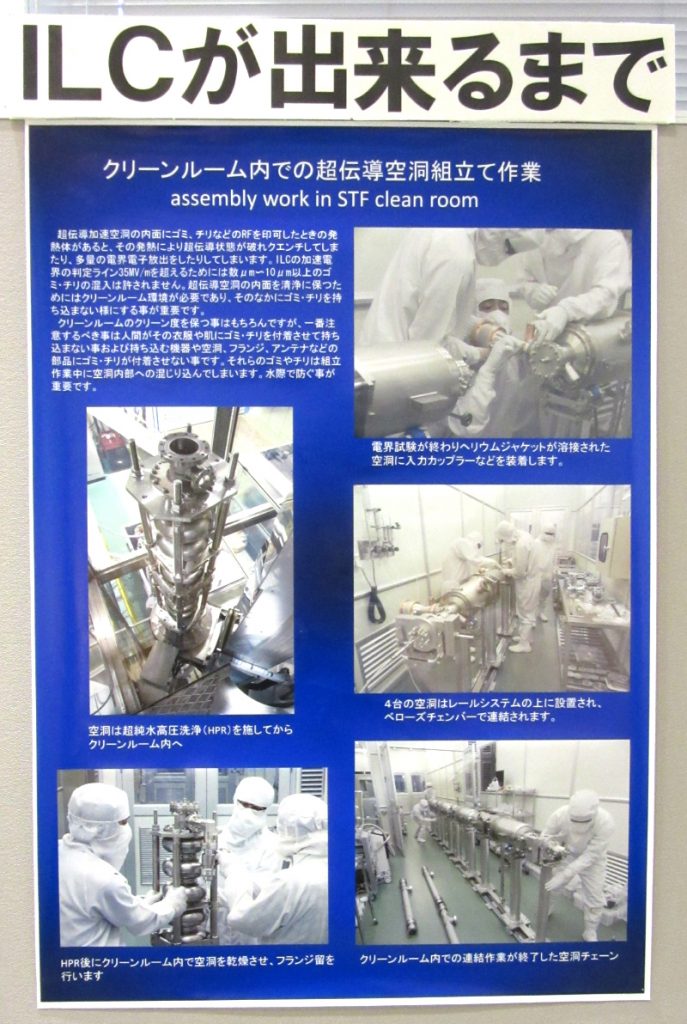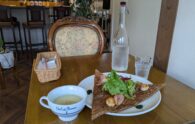Hello! Nice to meet you!
This article was written by Keitaro Tanaka (senior at Hirosaki University) and Fuka Oikawa (senior at Waseda University). We are two university students that have been hired by the Iwate Prefectural Government to start as civil servants in April 2020. On November 14, 2019, we spent a one-day internship at the Bureau of ILC Promotion at the Iwate government to learn about what it would be like at our future jobs.
While we were there, they took us to the Iwate ILC Open Lab to learn more about the ILC, so we’d like to share what we learned.
What’s the Iwate ILC Open Lab?
The ILC Open Lab was set up as a place to share information about the ILC, and a hub for industries, worker training, and research & development using the ILC. It was also built as a place where anyone can learn about the ILC, from businesspeople aiming to get involved in the accelerator industry, to local students. (Description quoted from “The Iwate ILC Open Lab”) There are many panel displays that tell you what the ILC is, how it will be created, and what the ILC will do.
Unfortunately, neither of us knew very much about the ILC at all, so it was a great chance for us to learn more about the ILC’s mechanisms and functions, and the history of the project.
Wait, what’s the ILC (International Linear Collider), again?
Let’s show you using the displays they had in the lab!
After you enter the room, the first thing to catch your eye will definitely be this large orange tube. This is called a cryomodule, and within is placed another tube-like object (resembling a baumkuchen cake) made out of a material called niobium. This superconductive cavity is one of the devices put together to make up the ILC. These tubes will be placed together in a line that could reach up to around 20 km long, and within, they’ll conduct experiments that might uncover the secrets behind the origins of the universe.
These experiments involve taking particles smaller than the eye can see (called electrons and positrons), and then smashing them together at close to the speed of light. This will recreate the conditions immediately following the Big Bang when the universe was formed. There, scientists may observe matter that we’ve never seen before, which is how they aim to unlock the mysteries behind the universe’s beginnings. If things go well, we’ll have taken our first step towards solving that mystery – but the ILC could have an effect on many other different fields as well.
What will the ILC do?
There are many things we might be able to do if the ILC is constructed.
For example, the healthcare industry: The ILC’s technology may be useful in cancer treatment, and they may make a quick discovery of new diseases. Maybe we might be able to develop a cure to diseases that are currently incurable.
Next, in the fields of IT and new materials: If they find new particles using ILC experiments, that may lead to new technological innovations in a number of different ways, from new information devices to the next generation of cameras.
It’s not just technology. If the ILC is created in Iwate, then people will come from all over Japan and the rest of the world to be involved with the ILC, of which there will be only one in the world. If those people live here for their research, then they’ll interact with all the local people, and through those interactions, we’ll learn so many things. This is a chance for us to learn about the world’s most advanced technology right here in our backyard!
What can you see at the Open Lab?
Within the Open Lab, there is a manga that explains the ILC.
To tell the truth, until we visited the Open Lab, neither of us knew what the ILC would do. But through reading this manga, we were able to deepen our understanding of the ILC project, and continued to learn more during our visit.
Even if you don’t know much about the ILC, we want you to feel welcome to visit the Open Lab facility. Even little kids can understand the manga, so families can come visit with their children. There’s also a lot of technical information as well, so it’s a great place for people who want to take a deep dive into particle physics.
You can also learn about the history of the ILC in Iwate at the Open Lab.
What surprised us is that people working towards the ILC in 1995, the year we were born. We had thought that the ILC was something that had just come about recently.
But in actuality, a physics workshop was held in Appi, Iwate in September 1995, and many people have been working towards the ILC for twenty or more years. You can learn about that and more about the ILC’s history if you visit the Open Lab.
Participating in the monthly THE KITAKAMI TIMES meeting
After returning from the Open Lab, we went with Yoshida-san of the ILC Bureau to the monthly meeting for THE KITAKAMI TIMES.
The meeting was also attended by Amanda-san (an Iwate civil servant) and Aimi-san (an Ichinoseki City worker). Before the meeting started, Yoshida-san told us, “Amanda and Aimi can only speak English, so we’ll be holding the meeting in English.”
They started off by discussing topics for the next issue and how their latest page views went, but the two of us had to work really hard just to follow along with our English skills.
After some time had passed, Yoshida-san blurted out, “To tell the truth, they can speak Japanese fluently.” Amanda-san and Aimi-san are actually great Japanese speakers, so they had just all been playing a trick on us! After that, the meeting was held in Japanese, with a quite relaxed atmosphere. They told us a lot about how interesting it was to be an Iwate civil servant, as well as different places we might work within the government.
【Editor’s Note】 Chikanori Yoshida, staff at the Bureau of ILC Promotion
I had our two university interns write this latest issue of THE KITAKAMI TIMES.
Both of them are brilliant students, and in their very short time with us (one day!) they investigated the ILC Open Lab, synthesized that information, and wrote this report.
Next April, these two will come to work at the Iwate government as civil servants. I’m not sure if they’ll be placed in the ILC Bureau, but I know the both of them will go on to have amazing careers.
Japanese
魅力発見!岩手ILC連携室オープンラボこんにちは!
弘前大学4年の田中奎太朗と早稲田大学4年の及川風香です。
私たち2人は、来年4月から岩手県職員として採用される予定の大学生です。2019年11月14日、私たちは、岩手県の職場実習に参加しILC推進局での勤務を経験することとなりました。
その際、ILCについて学ぶために「岩手ILC連携室オープンラボ」(以下「ILCオープンラボ」という。)を見学しましたので、その様子をレポートします。
「岩手ILC連携室オープンラボ」とは?
ILCオープンラボは、「ILCの情報発信拠拠点、ILCを契機とした産業、人材育成、研究開発の拠点として、関連産業の参入を目指す事業者や学生など、誰もが学習・研究できる施設」(「『岩手県ILCオープンラボ』について」より抜粋)です。「ILCって何?」「ILCってどうやってできるの?」「ILCができると何ができるの?」といった疑問に答えてくれる展示がたくさんある施設でした。
恥ずかしながら私たちはILCについてあまり知識がなかったのですが、ILCの仕組みや有用性、様々な歴史について詳しく知ることができる、とても有意義な機会となりました。
ILC(国際リニアコライダー)って何?
では、オープンラボにはどのような展示があるのでしょうか?これから、私たちが紹介していきます。
最初に展示室に入って一番に目を引くのがこの大きな黄色い筒のようなものです。これはクライオモジュールと呼ばれるもので、この中にニオブという物質で作られたバームクーヘンのような形の筒、超伝導加速空洞など様々な装置を組み合わせてILCが作られていきます。この筒は最終的には約20キロの長さまでつなげられ、この中で宇宙の始まりを解き明かすかもしれない実験が行われるのです。
実験は目に見えないほどの小さい粒子である電子と陽電子と呼ばれるものを光速に近い速さで衝突させるというものです。これによって宇宙が始まったビックバン直後の状態を再現し、そこで生まれたであろう、私たちがまだ見たことのない物質を観察し、宇宙の誕生の謎に迫ることが目的です。これがうまくいけば宇宙の謎を解き明かす一歩になるほか、様々な影響が生まれると考えられています。
ILCがあると何ができるの?
ILCが建設されることによってできるようになるかもしれないこと、それは様々です。
例えば医療の部門。ガンの治療に役立つこともあれば、病気の早期発見につながることもあります。現在の医療では治らないとされている病気が治る可能性が出てくるのです。
次に、情報通信や新機能材料の部門。実験で新たな粒子が発見されれば新しい通信機器や新しい世代のカメラなど、様々な面で技術革新が起こる可能性があります。
技術面だけではありません。もし岩手にILCができれば、世界に一つしか作られないILCのために様々な人々が県外や海外からやってくることでしょう。その人たちが研究のために住むようになればいろいろな人々と交流ができるほか、その人たちと関わることでさまざまなことを学ぶことができます。世界の最先端の技術がILCのために集まり、それを身近で学ぶことができるチャンスなのです!
オープンラボでは何が見られるの?
ILCオープンラボ内には、ILCについて説明する漫画もあります。
正直なところ、私たちはオープンラボを見学するまでは、ILCが何をする施設なのか分かっていませんでした。しかし、初めにオープンラボ内の漫画を読むことによって、ILCについての理解を深め、見学を進めることができました。
ILCを全く知らないという方も安心して見学に訪れてください。小さなお子さんも漫画なら分かりやすいと思いますので、ご家族で見学することもできます。そのほかILCについて専門的な知識を学習することができるため、しっかりと勉強したいという方にもオススメします。
また、オープンラボでは、岩手県のILCの歴史を知ることができます。
私たちが驚いたことは、ILCに関する活動は私たちが生まれる1995年から行われていたことです。ILCに関する活動は、つい最近になってから開始されたものだと思っていました。
しかしながら、実際には、1995年9月に岩手県の安比でワークショップが開催されており、20年以上前から活動がスタートしていました。このようにオープンラボでは、岩手県のILCの歩みを学ぶことができます。
『THE KITAKAMI TIMES』 定例スタッフ会議に参加
オープンラボの見学を終え、県庁に戻ってきた私たちは、ILC推進局の吉田さんの案内のもと、THE KITAKAMI TIMESの定例スタッフ会議に参加しました。
会議は、アマンダさん(岩手県職員)、アイミさん(一関市職員)も出席して行われました。私たちは会議が開始される前に「アマンダさん、アイミさんが英語しか話すことができないため、会議は英語を使って行われる。」と聞かされていました。
実際に次号のトピックについての話やアクセス数の増加について等の会話が行われ、私たち2人は必死で英語についていこうと耳を傾けていました。
その時にある吉田さんの言葉が聞こえました。「To tell the truth, they can speak Japanese fluently.(実を言うと、彼女たちは流暢に日本語を話すことができます。)」-アマンダさん、アイミさんは日本語を上手にしゃべることができたのです。つまり、私たちは、ドッキリに引っ掛かったのです!その後の会議は日本語で行われ、和やかな雰囲気の中、配属先や県職員として働く魅力などを教わることができたため、非常に意義があるものでした。
【編集後記】 岩手県ILC推進局 主査 吉田 知教
今回のTHE KITAKAMI TIMES 記事は、いわゆる「内定者」である2人の大学生に執筆していただきました。
2人とも大変優秀で、ILCオープンラボの内容をしっかり調査・視察し、終業時間までの短い時間の中で、このレポートを作成しました。
来年4月、彼らは私と同じ岩手県職員となります。ILC推進局に配属されるかは分かりませんが、活躍を大変期待しております。











